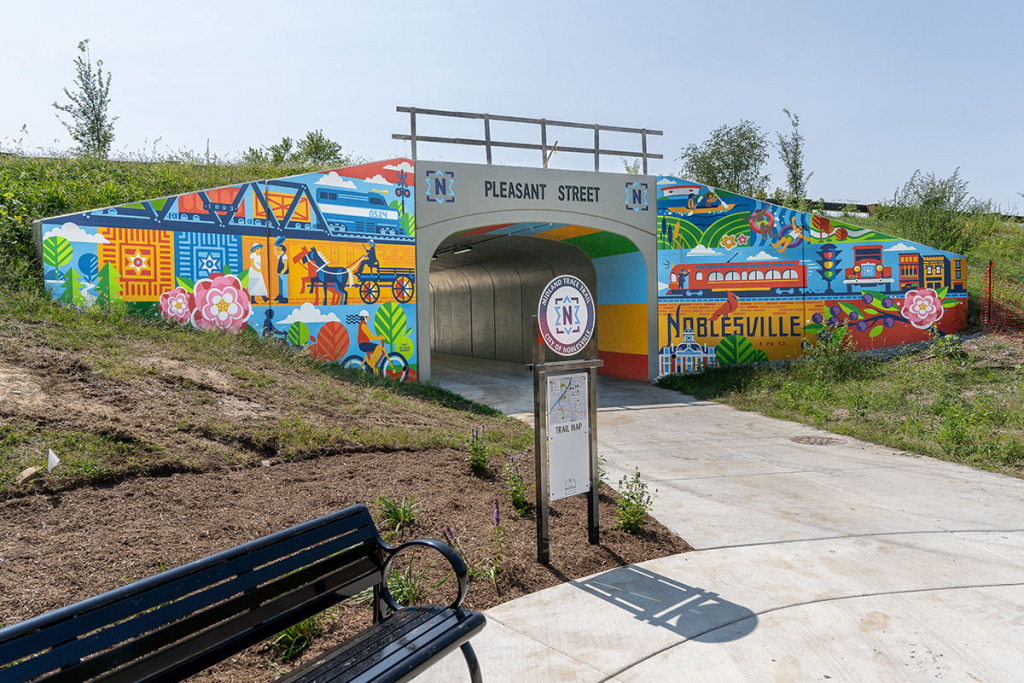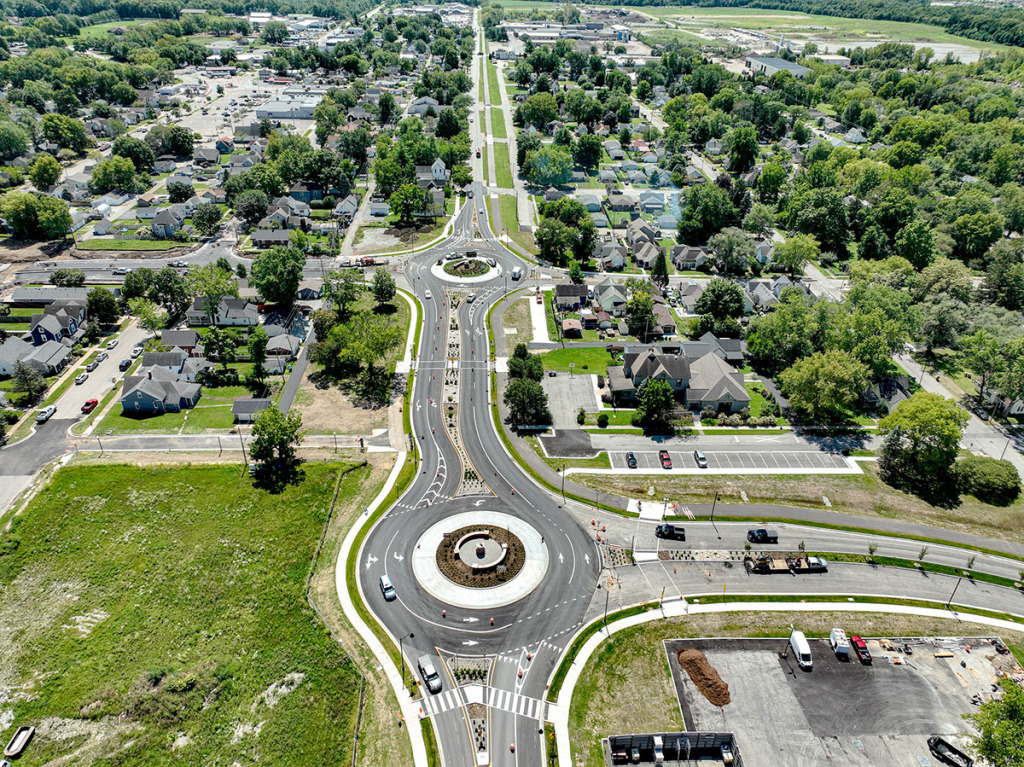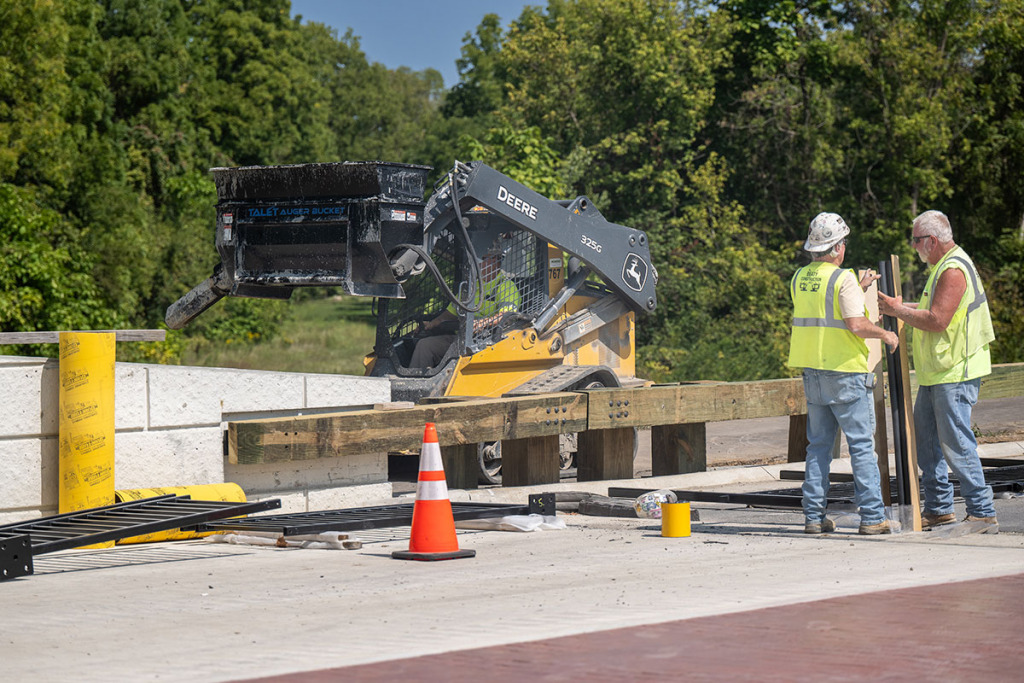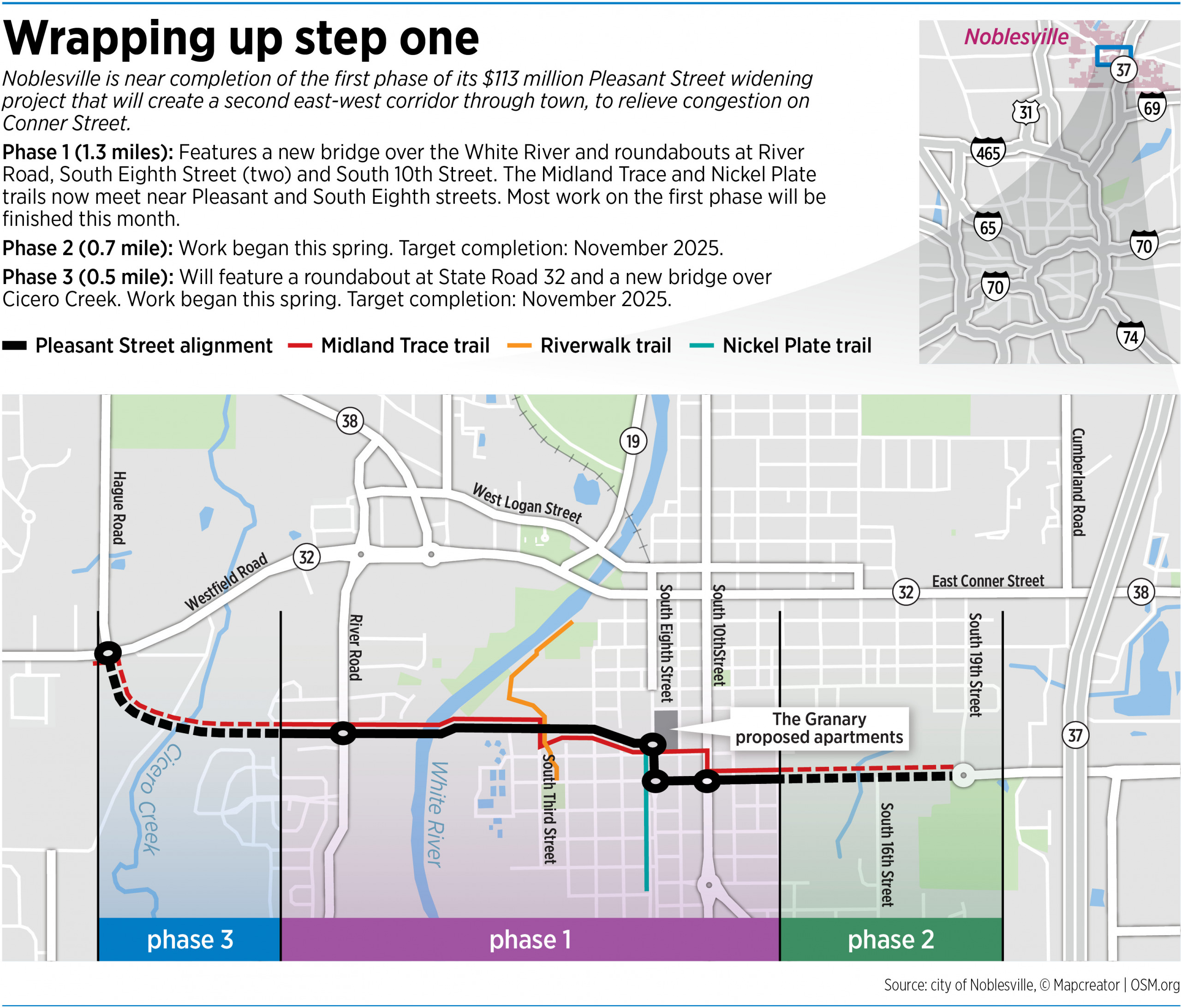Subscriber Benefit
As a subscriber you can listen to articles at work, in the car, or while you work out. Subscribe NowFor more than 40 years, Noblesville officials discussed building a second east-west corridor to alleviate downtown traffic congestion on Conner Street, which is also state roads 32 and 38. Now, there is finally light at the end of the tunnel for the largest infrastructure project in the city’s history.
In total, the $113 million, three-phase Reimagine Pleasant Street project involves extending, realigning and expanding Pleasant Street into a 2-1/2-mile corridor from State Road 32 to just west of State Road 37.
The city is preparing to open part of the project’s first phase to motorists on Sept. 27. The roughly 1-mile stretch of roadway from west of River Road to east of South Eighth Street features a new bridge over the White River. A roundabout will open at River Road; two roundabouts on South Eighth Street opened last year where Pleasant Street is realigned ahead of its new route to the west.
The remainder of the first phase will open later this fall once work is complete on a roundabout at the intersection of Pleasant Street and South 10th Street.
City leaders expect the second and third phases to be ready by November 2025. The second phase involves widening Pleasant Street east of South 13th Street and west of S.R. 37, while the third phase extends Pleasant Street from west of River Road to the intersection of S.R. 32 and Hague Road where a roundabout will be constructed.
Mayor Chris Jensen told IBJ that, while the Pleasant Street expansion should reduce downtown traffic up to 30%, it is “so much more than just an infrastructure project.”
As part of the first phase, a tunnel under Pleasant Street near South Third Street provides access for users of the Midland Trace and Riverwalk trails, and the Midland Trace and Nickel Plate trails will meet at Pleasant and South Eighth streets.
Trail users will find colorful murals on the tunnel, while art depicting White River scenes is on the pillars of the new bridge.
“I think it just signifies that Noblesville will put our foot down and say, ‘Hey, listen, we can do hard things. We can make big decisions. We can make wise decisions for our city’s future,’” Jensen said. “And I hope it’s a model for cities around the state.”
Noblesville is covering $98 million of the project cost, while Hamilton County is spending $15 million to build the White River bridge. In 2021, the Noblesville City Council approved motor vehicle excise and wheel taxes ranging from $25 for passenger vehicle registrations to $40 for commercial vehicle registrations to generate $1.8 million a year to chip away at the price tag.
City Engineer Alison Krupski said impacts on mobility, public safety, schools and drivers will be immediate.
“It is really hard to get east and west [through] Noblesville,” she said. “And, so, long term, we’re going to be able to see people wanting to travel to our downtown more to our businesses because it’s going to be easier to get there.”
City leaders expect the Pleasant Street project to lead to economic development growth on the south end of downtown. Already, Indianapolis-based Flaherty & Collins Properties has filed plans with the city to build a $67 million apartment development called The Granary along the corridor at the former site of the Noblesville Milling Co.
In recent years, Noblesville has focused on building mixed-use projects, like The Levinson, in its historic downtown core, and the Village at Federal Hill, west of the White River.
“We’re kind of shifting our focus so we can continue to expand that downtown footprint, but that southern end is certainly going to get some major focus over the next three years,” Jensen said.
‘A tough conversation’
Getting to this point was not easy.
Hamilton County Commissioner Steve Dillinger served on the Noblesville City Council from 1980 to 1984. During that time, Dillinger and other city leaders began examining ways to build an additional east-west corridor to relieve worsening downtown traffic on S.R. 32.
He said the city considered Logan Street before determining Pleasant Street would be the appropriate route. However, the plan stalled for four decades.
“I know government moves slow, but it shouldn’t take 44 years to build a road,” Dillinger said. “I think there’s a lot of reasons for that. It went through several different administrations and mayors, and most of them felt like maybe the hurdles were too high.”
Jensen made Pleasant Street a major focus of his 2019 campaign for mayor, but his administration encountered some of those hurdles early in the project.
Initially, his plan to extend Pleasant Street would have realigned the roadway between Fifth and Sixth streets through two blocks of single-family homes, some of which are more than a century old.
In March 2019, Southwest Quad Neighborhood Association residents successfully established the Plum Prairie Residential Historic District after a three-year effort. Had Noblesville continued to seek a route through the historic district, the city’s future state and federal funding for the project could have been jeopardized.
So, Jensen and the state selected a route that cut through a parking lot and green space on the former headquarters campus of IDI Composites International at 407 S. Seventh St. The state found that the route through IDI’s campus affected 22 fewer homes and avoided the historic district.
IDI leadership threatened to leave Noblesville over the move, but the company in 2022 reached a deal with the city to build a $24 million manufacturing facility in a new business park along S.R. 37, north of 150th Street. IDI expects to open its new headquarters next month.
“Which I think ultimately is a win for them and a win for us,” Jensen said.
Businesses in the path of the chosen route, such as El Camino Real Restaurant, Firehouse Pizza and Dairy Queen, received eminent domain notices and closed. The city purchased 80 properties for the road expansion.
“Anytime you put a new corridor through a downtown, that’s a tough conversation,” Jensen said. “I still hear about El Camino having to close. That was a very, very tough one for a lot of people in the community.”
Now that he is the one making the decisions, Jensen said he understands why making Pleasant Street a reality was so difficult for so long.
“But I 100% believe it was the right thing to do,” he said. “It needed to be done, should have been done 30 years ago, but we’re doing it now.”
Dillinger, the longest-serving county commissioner in Indiana who was first elected in 1989, recalled when Hamilton County looked to reconstruct 146th Street in the early 2000s—another controversial move.
“You have to do the right things for the right reasons. They’re not always popular,” he said. “If it’s the right thing to do, you just have to bear it and do what you need to do.”
Inviting development
City Council member Aaron Smith, who represents areas along the Pleasant Street route, expects the south end of downtown Noblesville will experience a boom thanks to the new corridor.
He pointed to The Granary project and to Bier Brewery, which opened last year at 1618 S. 10th St., as examples of how the area is already gaining new business and development. The Granary, he added, is the first mixed-use project to be planned on a trail in Noblesville.
The Granary, which is moving through the city’s approval process, would be on the northern part of the former Noblesville Milling Co. site and bounded by Mulberry Street to the north, South Ninth Street to the east, Walnut Street to the south and South Eighth Street to the west.
The southern portion of the site would have a trailhead for the Midland Trace and Nickel Plate trails and include public restrooms and lockers.
The project would feature a four-story building and parking garage with 225 luxury apartments, 5,000 square feet of retail space and about 300 structured parking spaces for residents and the public.
“With new tunnels, murals, trails and spots like The Granary and Bier Brewery that have come in, I think [the Pleasant Street project is] a great asset for that part of town that hasn’t seen [development] in a long time,” Smith said.
He added that projects along the Pleasant Street corridor will need to be built in a way that accentuates the neighborhood “instead of just blowing through it.”
Flaherty & Collins Principal Deron Kintner said The Granary’s proximity to downtown Noblesville with its shops and restaurants made the location a good fit. The development company started discussions about a project at the site in 2017 and made progress in 2018 before putting plans on the shelf while the Pleasant Street project advanced.
“It’s also essentially the south gateway into Noblesville,” Kintner said. “So, we add all that up, with what we’re doing, we think it’s a place that people that currently live in Noblesville, as well as people [who] live outside of Noblesville but would like to move into Noblesville, will find an attractive place to settle down.”
With the Pleasant Street project set to cross the finish line next year, Jensen said Noblesville is ready to start shifting its downtown focus even farther south.
“We’re just going to take what we learned from every one of those [downtown] projects and apply them to any redevelopment opportunity along the way,” he said.•
Correction: An earlier version of this story said Pleasant View Baptist Church was among the businesses and churches that received eminent domain notices and closed for the construction of Pleasant Street. The church remains open at 825 S. 11th St. in Noblesville.
Please enable JavaScript to view this content.










The two round-abouts on 8th street when all the construction is finished will be a traffic nightmare similar to the two round-abouts on 32 near the hospital. Come on man, the round-abouts are too small in diameter and too close together for smooth traffic flow.
This trail expansion is amazing. Did they repurpose the Midland Trace railroad trestle? That would really cool.
The trail extension over the river is probably the only part of this project that can be construed as progress. No, the bridge didn’t make it. It was sent down the river to Conner Prairie. I think its in storage. This is one ugly scar through an urban neighborhood. Dozens of homes and businesses were bulldozed to carve a 100 foot right of way right through the south side (the only economically challenged census tract in the county). A once thriving urban intersection (businesses on four corners) is now a roundabout wasteland. The south side is severed from downtown. The city had to spend millions to relocate an industrial business that was displaced by the project and threatened to leave town. Through it all, leadership ignored pleas to take a less destructive route. Robert Moses would have been proud of this project. Its a 20th century traffic solution launched more than 2 decades into the 21st century, plus roundabouts. Its great for people who want to get through town quickly without stopping but terrible for those of us who live here and have to pay for it.
Michael C., you get a gold star for the reference to Robert Moses. I’m just old enough to remember attending the 1964-65 New York World’s Fair. I learned about Moses while reading up on his role in that event, which subsequently led me to learn about his long history of enforcing “improvements” upon New York City’s roadway system. He was quite the character. As for the Noblesville project, I’ve seen the construction and it sure does look like more of a scar than an improvement. I understand the problems all that traffic poses for downtown Noblesville, but I am somewhat skeptical that this is the best solution … especially with that 90-degree turn anchored by two very close roundabouts on 8th Street.
This project will be a huge economic boom for this part of the city as well as help eleviate the traffic issues around the square. Change is hard but some people have the intestinal fortitude to make the hard decisions for the greater good. Thank You Mayor Jenson for leading this charge.